 |
| Home | Articles | Mantelpieces in New England: An Introduction |
 |
|
|
Until the widespread introduction in the 1830s of airtight cast-iron parlor stoves and kitchen cook stoves,1 fireplaces were essential for heating and cooking in the New England home. Fireplaces returned to favor in the centrally heated houses of the late nineteenth century, primarily because of their aesthetic appeal. A house fitted with an open fireplace has remained a desirable luxury ever since, with present day real estate listings often making note when one or more are present.
 |
|
Fig. 1: Governor John Langdon House, exterior, 1783–1786. Society for the Preservation of New England Antiquities. Photography by Johanna McBrien.
|
Although the fireplace has been a fixture in the home during much of this country’s his-tory, the mantel-piece (or chimney-piece)—an ornamented enframe-ment with a shelf above the fire-place opening—has not always been present as a distinct architectural feature. Ordinary Amer-ican houses of the seventeenth and eigh-teenth centuries, for example, seldom had mantelpieces. Except for kitchen fireplaces, which commonly had a high shelf for the storage of candlesticks and cooking utensils, most hearth openings were simply trimmed with wooden casings that duplicated those used around doorways in the same rooms (Fig. 2). Some eighteenth-century homes that integrated mantels and fireplace surrounds had their fireplace openings framed by simple bolection molding of bold, convex profile. This relatively plain treatment varies from what most people are familiar with through visits to historic colonial houses (Figs. 1, 1a) built by wealthy merchants and prominent citizens. These houses often feature elaborate interiors and were in large part preserved for their architectural components and historic connections. The homes representative of the average early household, with minimal interior embellishment, survive as private dwellings, but are generally not seen by the traveling public.
 |
|
|
Fig. 1a: Parlor mantelpiece, Governor John Langdon House, 1783–1786. Society for the Preservation of New England Antiquities. Photography by Johanna McBrien.
|
Despite the relative rarity of mantelpieces in eighteenth-century American houses, British architectural pattern books illustrating a wide range of chimneypiece designs were available. British builders’ manuals, purchased from American booksellers, were the most readily accessible design sources for simplified versions of elaborate English mantelpieces. More expensive English architectural folios, sometimes found in the libraries of wealthy colonial merchants and businessmen, illustrated highly elaborate designs, most of which were intended for marble fireplaces rarely interpreted in America.
Perhaps one of the most notable examples of an American home outfitted with a copy of a British chimneypiece design is the Benning Wentworth mansion (Fig. 3) in Portsmouth, New Hampshire, the country home of the first royal governor of the then province. Wentworth’s great mantelpiece, executed in native pine in the 1750s, follows the marble original drawn by designer William Kent (1685–1748) in 1725 for Houghton Hall in Norfolk, England, the home of British prime minister Sir Robert Walpole (Fig. 4). Somewhat compressed in its proportions in comparison to its source, the grand chimneypiece was fashioned by local craftsmen from a book plate in either a 1727 folio by Kent or a less costly plagiarized volume of 1737.
 |
|
Fig. 3: Chimneypiece, Governor Benning Wentworth Mansion, Portsmouth, New Hampshire, attributed to Ebenezer Dearing (1730–1791), ca. 1753. Pine.
|
After the Revolution a new generation of architectural books (Fig. 5) spurred a growing impetus to include a mantelpiece in every American home (at least in the best rooms). These volumes reflected the delicate designs of popular British neoclassical architect Robert Adam (1728–1792). Two such books, William Pain’s The Practical Builder (London, 1774) and The Practical House Carpenter (London, 1788) were reprinted in Boston in 1792 and 1796, respectively, exemplifying their popularity. Soon thereafter, the first American architectural writer made his influence felt. Asher Benjamin (1773–1845), a native of Connecticut, published The Country Builder’s Assistant in 1797 (Fig. 6). Crudely engraved in comparison to its British prototypes, Benjamin’s book nevertheless had a transforming effect on American buildings. His mantelpiece designs dispensed with the heavy molded overmantel panels that were typically part of the fashionable fireplace wall in the early and mid-eighteenth century. His designs usually included an architrave or casing around the fireplace opening, with a frieze board and a molded cornice supporting a mantelshelf above.
American joiners quickly elaborated such basic designs. By about 1800, American mantelpieces often included thin colonnettes beside the fireplace opening (Fig. 7); enrichment by chip carving, reeding, or applied molded latticework; and a projecting mantelshelf supported by thin moldings beneath. Some designs included bas relief ornamentation in a neoclassical style. In many cases, the classical figures, urns, bellflower swags, and other elements of such decoration were executed in “composition,” a molded material sold by importers or by manufacturers in Boston, New York, and Philadelphia and glued to the surfaces of the mantelpiece. A few masterful carvers, like the legendary Samuel McIntire (1757–1811) of Salem, Massachusetts, executed such details in wood.
 |
|
|
Fig. 7: Chimneypiece, Rundlet-May House, Portsmouth, New Hampshire, 1807–1808. Carved basket of flowers and column capitals attributed to William Dearing in the manner of Samuel McIntire. Courtesy of the Society for the Preservation of New England Antiquities; photography by David Bohl.
|
The American interpretation of the British Adam style is called the “federal” style. The federal era, which extended from about 1790 into the 1820s, brought not only the widespread use of the mantelpiece but also a change in the proportions of the American fireplace. Eighteenth-century fireplaces tended to be deep, with a rather square plan to their fireboxes. By contrast, most federal-period fireplaces were built on a plan devised by the American-born Loyalist Benjamin Thompson (1753–1814), better known as Count Rumford.2 Rumford fireplaces are shallower than their predecessors and have widely splayed cheeks that radiate the heat of the fire into the room to improve fuel economy. Still greater fuel economy was gained toward the end of the federal period by the introduction of the cast-iron fire frame. Fire frames have no bottoms or back plates and fit within the fireplace, projecting forward beyond the mantelpiece.3 By bringing the fire still farther forward than did the Rumford fireplace, fire frames radiated even more heat into the room, and their heavy cast iron retained warmth. No further evolution of the fireplace proper occurred after the introduction of Count Rumford’s design, but the mantelpiece continued to change in response to later styles.
With the 1820s, Americans saw the introduction of the Greek Revival style, which swept away the delicate detailing and thin moldings of the federal period. Ordinary Americans had become fascinated with Greek culture during the 1820s when the Greeks were engaged in a war to wrest themselves from Turkish domination, a war of independence to which many Americans felt they could relate.4 Tales of Turkish cruelty and the plight of Greek refugees gave birth to a deep interest in Greek culture, ancient and modern.
|
|
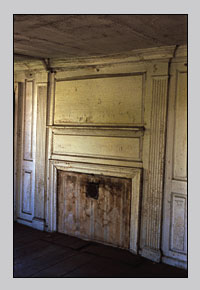 |
Fig. 2: Joshua Wentworth House, Portsmouth, New Hampshire ca. 1770 (currently awaiting restoration). Strawbery Banke Museum. The thin shelf was added after 1800. Photography by Johanna McBrien.
|
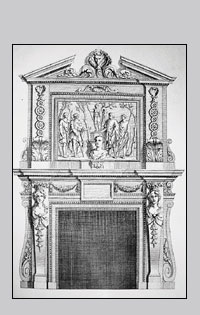 |
Fig. 4: Plate from William Kent, The Designs of Inigo Jones (London, 1727). This illustration of Kent’s design of a chimneypiece for Houghton Hall in Norfolk, England, was the prototype for the Wentworth chimneypiece.
|
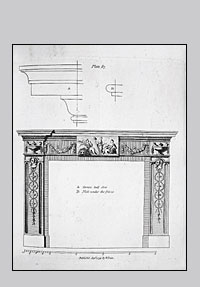 |
Fig. 5: Plate from William Pain, The Practical House Carpenter, 5th edition (London, 1794). First published in 1788, this volume disseminated the Adam style through at least eleven editions, becoming one of the most often reprinted of all architectural books.
|
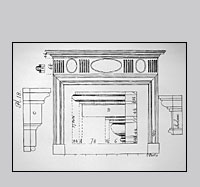 |
Fig. 6: Plate from Asher Benjamin, The Country Builder’s Assistant (Greenfield, Mass., 1797). Benjamin’s volume, the first architectural guidebook compiled by an American, had a powerful influence in disseminating the American federal style.
|
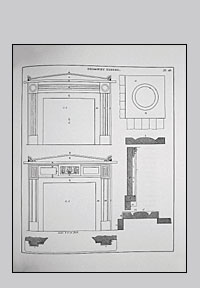 |
Fig. 8: Plate from Asher Benjamin, The Practice of Architecture (Boston, 1833). This volume marked the transition from the federal to the Greek Revival style. Plate illustrates a typical Greek Revival mantelpiece.
|
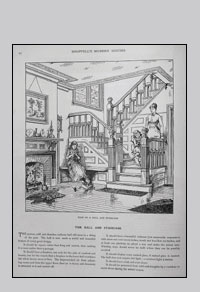 |
Fig. 10: Plate from Selected Designs from Shoppell’s Modern Houses (New York, 1890). By the late 1800s, the open fireplace, often placed in stair halls and accompanied by a built-in seat or inglenook, returned to the more expensive houses.
|
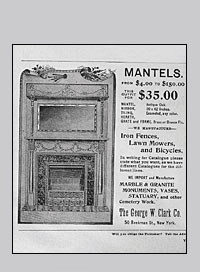 |
Fig. 12: Advertisement from American Homes magazine, 1895, showing a moderately expensive Colonial Revival-style mantelpiece with an overmantel mirror.
|
|
|
When immigrant architects like French-born Benjamin Henry Latrobe (1764–1820) began to design public buildings in the form of Greek temples, Americans were ready to turn away from the long-familiar federal style, adopting instead the Greek Revival, popularly referred to as the national style.
|
 |
|
|
Fig. 9: Mantelpiece, Loudon, New Hampshire, ca. 1850. Pine. Greek Revival mantelpieces were deliberately made simple and heavy. This example was probably made to accompany an airtight stove, not an open fireplace.
|
Because the fireplace was alien to ancient Greek architecture, designers devised a mantelpiece that incorporated elements of the Greek style (Fig. 8). For instance, Asher Benjamin simplified and coarsened every element, creating the suggestion that a pine chimneypiece was constructed of slabs of marble, or even that it was a small Grecian temple supported by columnlike side pieces. To heighten this illusion, the shelves of many Greek Revival mantelpieces have a peaked backboard against the wall, suggesting the low-pitched pediment of a Doric temple (Fig. 9).
With the discovery and increasing availability of varieties of American marble, it was not long before the illusion of the marble mantelpiece gave way to reality. By the mid-nineteenth century, fashionable houses were being fitted with chimneypieces of polished and carved marble, or else of less expensive slate that was cleverly enameled by a process to imitate marble. By this period, open fires were giving way to stoves, or even to central furnaces. People who preferred an open fire usually burned coal in a grate, rather than wood on andirons.
|
|
 |
|
Fig. 11: Dining room chimneypiece, Codman House, Lincoln, Massachusetts, ca. 1863–1864. Courtesy of the Society for the Preservation of New England Antiquities; photography by David Bohl.
|
By the 1850s, the stove and the furnace had banished the fireplace from the homes of less well-to-do Americans, who could afford neither the unnecessary cost of building a massive chimney nor the luxury of burning valuable fuel for aesthetic effect when a stove offered far greater efficiency. But because of the socioeconomic stature a fireplace implied, it was not uncommon in the ordinary homes of the late nineteenth and early twentieth centuries, to find a mail-order mantelpiece, often surmounted by a plate-glass mirror, affixed to a parlor wall in spite of the lack of an accompanying fireplace and chimney.
More prosperous homeowners continued to enjoy the hypnotic beauty of the open fire while basking in the even temperature afforded by a coal-fired boiler or furnace in the basement. In late-nineteenth-century houses of the more well-to-do, the fireplace assumed a symbolic role. Perhaps inspired by the colonial rooms that were installed at the 1876 Philadelphia Centennial Exhibition celebrating American independence, Americans came to regard the open fire as redolent of the virtues of times past. American architects began to situate fireplaces in stair halls as well as in parlors, often ensconcing the hearth within an “inglenook,” a cozy alcove that favored quiet reading or contemplation (Fig. 10). Mantelpieces of the late nineteenth century displayed as many stylistic vocabularies as did dwellings and furniture of that era, and, as in the preceding periods, were designed as an important component of the interior decorative scheme (Fig. 11).
Mantelpieces have continued to follow the succession of architectural styles that have marked changes of taste. The craftsman style brought its own simplicity to mantelpieces of the early twentieth century, as did the taste for log cabins and fieldstone fireplaces. The clean lines of the modern movements have resulted in simplistic fireplace surrounds with mantels indicated only with a line of steel, or with no present decorative elements. The Colonial Revival style, more than a century old and as strong as ever, has ensured the continued use of mantelpieces (Fig. 12) that would have looked familiar to those who first introduced these features to American homes.
|
James L. Garvin has served since 1987 as New Hampshire’s state architectural historian. He was previously curator at Strawbery Banke, Inc., and at the New Hampshire Historical Society. His latest book is A Building History of Northern New England (University Press of New England, 2001). A reprint of NHHS’s On the Road North of Boston: New Hampshire Taverns and Turnpikes, 1700–1900, which he co-authored with Donna-Belle Garvin, will be available in spring 2003.
All illustrations, unless noted, courtesy of the author.
|
|
|
- Cook stoves were smaller than the later kitchen ranges. The former had ovens accessible from the sides, and low, flat cooking surfaces, perhaps to accommodate cooks who were used to bending down when hearth cooking.
- Thompson was knighted in 1792 by the Elector of Bavaria, and assumed the title of Rumford, an early name for Concord, New Hampshire. He was honored for his services in rounding up the beggars of Munich, placing them in workhouses, and setting them to work, and for introducing cooking and other facilities for their support. His experiments in large-scale cookery led to the later introduction of Rumford cookers (roasters) in American homes.
- Fire frames are related to the Franklin stove, introduced in the early 1740s. The design of the latter proved impractical and inefficient and was not widely used until remodeled by David R. Rittenhouse in the 1790s.
- The Greek War of Independence (1821–1829) ended 400 years of domination by the Ottomans.
|
|
|